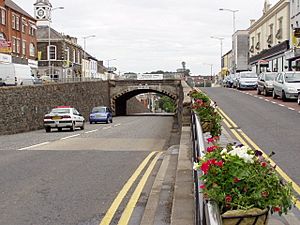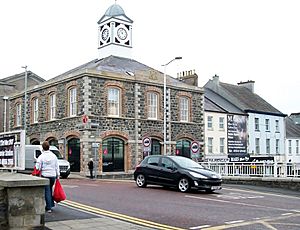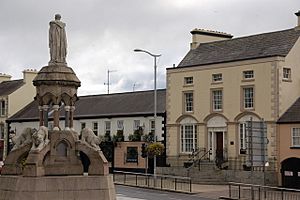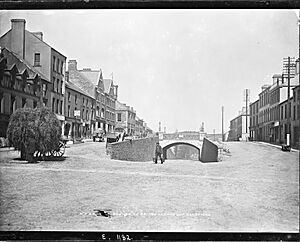Banbridge facts for kids
Quick facts for kids Banbridge
|
|
|---|---|
 'The Cut' in Banbridge |
|
| Population | 17,400 (2021 census) |
| • Belfast | 21 mi (34 km) |
| District |
|
| County | |
| Country | Northern Ireland |
| Sovereign state | United Kingdom |
| Post town | BANBRIDGE |
| Postcode district | BT32 |
| Dialling code | 028 |
| Police | Northern Ireland |
| Fire | Northern Ireland |
| Ambulance | Northern Ireland |
| EU Parliament | Northern Ireland |
| UK Parliament |
|
| NI Assembly |
|
Banbridge is a town in County Down, Northern Ireland. It sits by the River Bann and the A1 road. The town gets its name from a bridge built over the River Bann way back in 1712.
Banbridge started as a place where coaches would stop on the busy road between Belfast and Dublin. It became very successful because of its Irish linen factories. Today, Banbridge is part of the Armagh City, Banbridge and Craigavon Borough Council. In 2021, about 17,400 people lived there.
The main street in Banbridge is quite unique because it goes up a very steep hill. In 1834, a special underpass was built. This was because horses pulling heavy loads would get too tired before reaching the top of the hill! This underpass is officially called 'Downshire Bridge', but most people call it "The Cut".
Contents
History of Banbridge
Banbridge is a fairly new town. It first appeared in records around 1691. The town grew up where the main road from Belfast to Dublin crossed the River Bann.
Linen Industry and Growth
The town's success came from flax and the linen industry. By 1772, Banbridge was a major linen-producing area in Ireland. It became even more important around 1820 as a stopping point for mail coaches between Dublin and Belfast. A gift of £500 from the Marquis of Downshire helped improve the steep road, which was a big help for the town's growth. While the linen industry is smaller now, Banbridge still has important linen producers like Weavers, Thomas Ferguson & Co, and John England Irish Linen.
In 1994, Banbridge became a twin town with Ruelle-sur-Touvre in France. This means the towns have a special friendship and connection.
Times of Conflict
Banbridge, like many places in Northern Ireland, has seen periods of conflict.
In 1920, during the Irish War of Independence, there was unrest in the town. After a British colonel with family ties to Banbridge was killed in Cork, some people in Banbridge reacted strongly. Many homes and businesses were attacked. This led to some families leaving the town. The British Army eventually helped bring calm back to the area.
Later, during a period known as the Troubles, Banbridge experienced some serious incidents. There were three major bombings in the town. In 1982, a bomb on Bridge Street caused damage and injured people, including a schoolboy. In 1991, another large bomb caused widespread damage. Even after the Good Friday Agreement brought more peace, there was another bombing in 1998. These events caused damage and upset, but the town has since moved forward.
Townlands in Banbridge
The Banbridge area is divided into smaller areas called townlands. Their names often come from the Irish language. Banbridge itself started in a townland called Ballyvally. As the town grew, it expanded into nearby townlands, and their names are now used for streets and housing areas. Here are some examples:
- Ballydown (meaning "townland of the stronghold")
- Ballymoney (meaning "townland of the thicket")
- Ballyvally (meaning "townland of the routeway")
- Edenderry (meaning "hill-brow of the oak-wood")
People in Banbridge
In 2021, Banbridge had a population of 17,400 people. The town is a mix of different backgrounds and identities.
Places to Visit

Near Banbridge, you can find old historical sites like Lisnagade Fort, Legannany Dolmen, and the Loughbrickland Crannóg, which was built around 500 AD. The Old Town Hall in Banbridge was finished in 1834.
In the middle of Banbridge, there's a large park called Solitude Park. It's a community space with skateparks, rivers, and grassy areas.
Famous People from Banbridge

Many notable people have connections to Banbridge:
- Captain Francis Crozier, a British naval officer and Arctic explorer, was born here in 1796.
- Robbie Dennison, a former Northern Ireland football player.
- Dermott Lennon, a world champion in show jumping.
- F. E. McWilliam, a famous surrealist sculptor.
- Joseph M. Scriven, who wrote the well-known hymn "What a Friend We Have in Jesus".
- John Butler Yeats, a well-known artist and father of the famous poet William Butler Yeats.
Getting Around Banbridge
Banbridge is located on the A1 main road, which connects Belfast and Newry. The closest train station is at Scarva, about 4 miles away.
Banbridge used to have its own railway station from 1859 until 1956. Trains connected Banbridge to places like Scarva, Lisburn, and Belfast Great Victoria Street. Over time, the railway lines were closed, and now people mostly travel by road.
Education in Banbridge
Banbridge has several schools for different age groups:
Primary Schools
- Abercorn Primary School
- Ballydown Primary School
- Bridge Integrated Primary School
- Bronte Primary School
- Edenderry Primary School
- Milltown Cemetery Primary School
- St. Mary's Primary School (Catholic)
Post-primary Schools
- Banbridge Academy
- Banbridge High School
- St Patrick's College, Banbridge
- New-Bridge Integrated College
Sports in Banbridge
Banbridge has many sports clubs:
- The Banbridge Hockey Club plays at Havelock Park.
- Clann Na Banna (founded 1903) is the local Gaelic Football and Hurling club.
- Other clubs include Banbridge Bowling Club, Banbridge Town F.C., Banbridge Rangers, and Banbridge Rugby Club.
Banbridge in Pop Culture
- The famous song "The Star of the County Down" is connected to Banbridge.
- One of the sets for the TV show Game of Thrones is at Linen Mill Studios in Banbridge.
See also
 In Spanish: Banbridge para niños
In Spanish: Banbridge para niños




